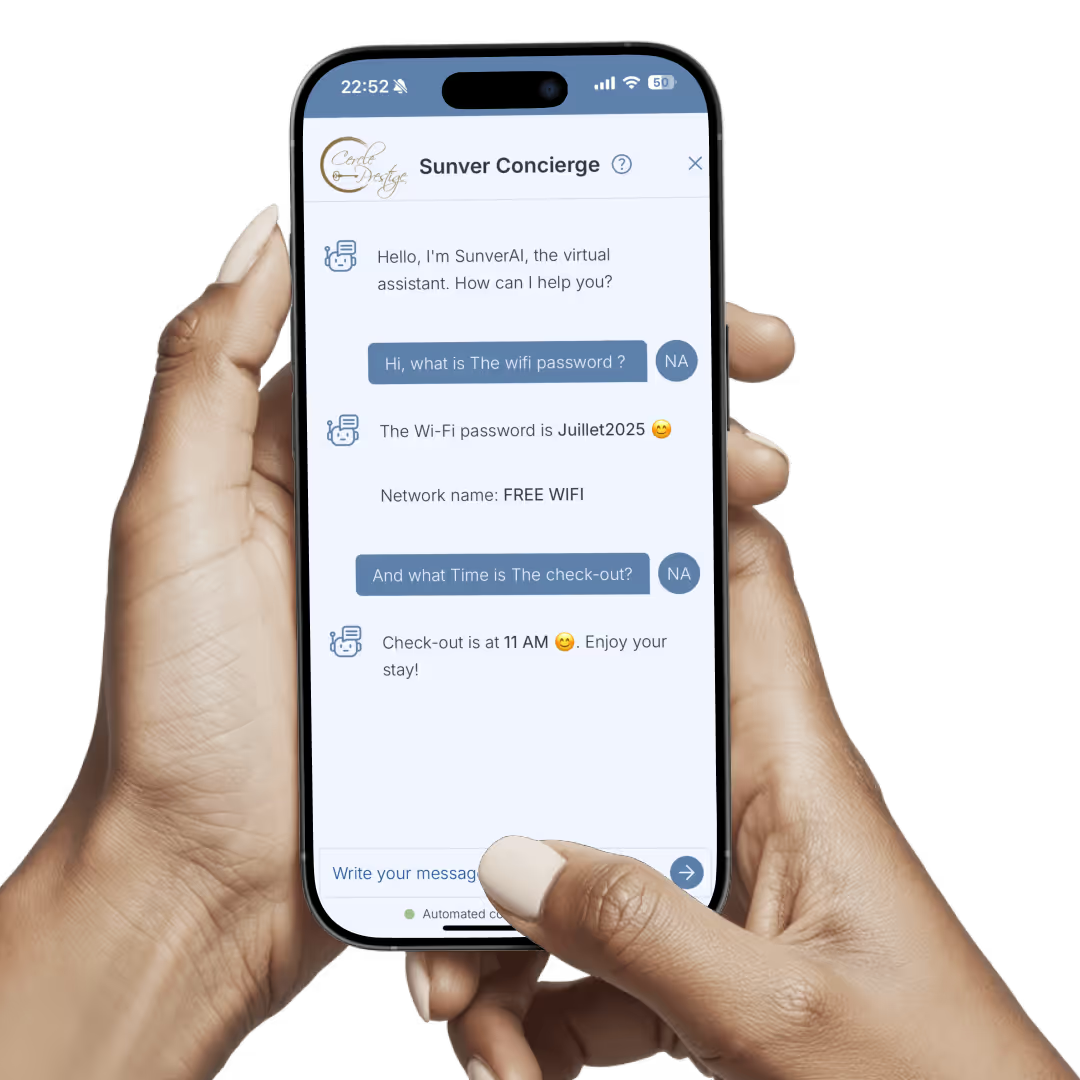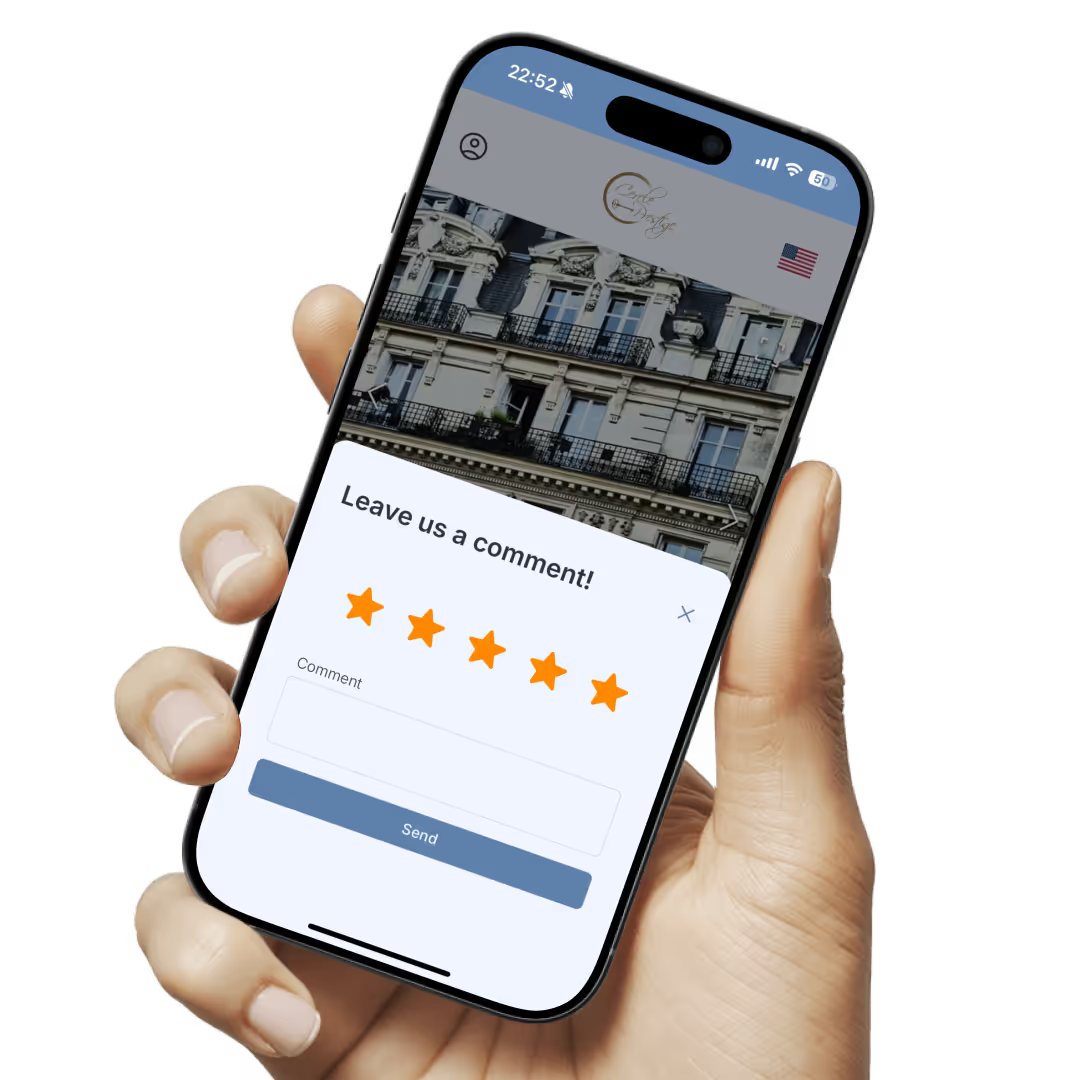Digital Welcome Guide: A Simple Step Toward More Sustainable Short-Term Stays
Switching from paper to digital is one of the simplest ways to make your short-term rental more sustainable. A digital welcome guide centralizes guest information, reduces paper waste, and encourages eco-friendly habits — from saving water to supporting local businesses.

Sustainable tourism: a growing priority
Sustainable tourism has become a key priority for both travelers and hosts. In this transition toward more responsible practices, every detail matters.
One of the simplest and most effective actions is to replace the traditional paper welcome guide with a digital version. Practical, eco-friendly, and modern, this digital tool has become essential for offering a smooth and environmentally conscious guest experience.
What is a digital welcome guide ?
A digital welcome guide is a dematerialized version of the trwaditional physical guide that hosts provide to their guests.
It gathers all essential information for the stay: check-in and check-out instructions, Wi-Fi codes, equipment use, house rules, local recommendations, and any additional services offered.
Unlike a paper document or static PDF, the digital welcome guide can be interactive and accessible online. Guests can view it anytime from their smartphone, tablet, or computer, simply by scanning a QR code or clicking a link.
The differences between paper and digital welcome guide ?
The paper welcome guide has long been a staple in short-term rentals, but it now shows its limits.Each modification, whether it’s a new Wi-Fi code, an updated schedule, or a new recommendation, requires a complete reprint, leading to high paper and ink consumption and wasted time.
The digital welcome guide, on the other hand, requires no printing at all. All information can be updated instantly from a simple online dashboard.
It offers an interactive experience: guests can click on links, view maps, book activities, or ask questions at any time.
More than just eco-friendly and modern, the digital welcome guide also strengthens the host’s professional image and supports an eco-responsible, sustainable approach.
The ecological advantages of a digital welcome guide
Reducing environmental impact
Switching to digital eliminates repeated printing and reduces the use of natural resources.
It’s a simple but concrete way to lower one’s environmental footprint while improving property management.
Instant and unlimited updates
Information can be updated in real time, without wasting paper.
This ensures content that is always reliable, consistent, and aligned with guest needs.
A multilingual experience
Many solutions offer automatic translation of content into multiple languages, avoiding the need for several printed versions and making the information accessible to all types of travelers.
Creating information modules to encourage eco-friendly habits
Another often-overlooked benefit of the digital welcome guide is its ability to raise guest awareness about responsible consumption.
Hosts can create dedicated sustainability modules, such as:
- tips to save water (shorter showers, reusing towels, running the dishwasher only when full),
- advice to limit energy use (turning off lights, adjusting air conditioning, opening shutters in the morning),
- or guidelines for proper waste sorting and using local recycling points.
These personalized sections help educate guests without constraints, they are informed in a positive, engaging way directly from their phone.
The digital guide thus becomes a true environmental awareness tool, fully aligned with an establishment’s CSR approach.
Promoting local businesses and activities
The digital welcome guide is also an excellent way to promote local networks and foster a more authentic and circular form of tourism.
Short-term rental hosts can include personalized recommendations: independent restaurants, artisans, local producers, markets, excursions, or nearby services.
By adding direct booking links or establishing partnerships with local businesses, the digital guide becomes a genuine driver of the local economy.
It allows guests to discover unique, often more sustainable experiences, while supporting small local enterprises.
This approach benefits everyone: it enhances guest satisfaction, boosts the local economy, and aligns perfectly with the principles of responsible, community-rooted tourism.
Facilitating the achievement of a green certification
A digital welcome guide can also play a key role in obtaining or renewing an environmental certification such as Green Key.
These labels reward establishments committed to sustainability, particularly in waste reduction, energy management, water conservation, and guest education.
By digitalizing the welcome guide, hosts demonstrate their commitment to reducing printed materials, communicating clearly about environmental actions, and encouraging responsible behaviors within their property.
By including sections dedicated to waste sorting, water-saving measures, or eco-certified partners, the digital guide becomes tangible proof during a certification audit, a simple and visible way to reinforce environmental engagement while appealing to travelers sensitive to sustainability.
In conclusion
Adopting a digital welcome guide is more than just modernization, it’s a meaningful step toward more sustainable and human tourism.
By reducing printing, simplifying communication, and improving the guest experience, it stands out as a simple, effective, and planet-friendly solution.
Platforms like Sunver now make this transition easy by combining user-friendliness, flexibility, and environmental responsibility.
Much more than a welcome guidebook
A web application accessible without download, via QR code or link, automatically translated into your guest’s language.




Frequently asked questions
Everything you need to know about Sunver.
What is Sunver?
Sunver is a solution that allows you to easily create your own digital welcome guidebook to simplify communication with your guests. It enhances the guest experience, saves you time every day, and helps you generate additional revenue. Setting up a guidebook is intuitive—similar to creating a Facebook profile.
How do I set up Sunver?
You can create your first guidebook directly from our website in just a few minutes and experience the simplicity of the solution for yourself. If you are a hospitality professional, our team also offers a full demo via video call, helping you with setup and customization.
How can I share my guidebook with guests?
There are two main ways to share your guidebook:
1. Send the link directly after booking or during the stay through your automated messages.Provide
2. QR code displays inside your accommodation so guests can scan and access the guidebook instantly.
You can also print your display for free from your Sunver dashboard or order physical QR code supports directly from our website.
Do my guests need to download anything?
No, your guests don’t need to download anything. Sunver runs as a web app, meaning it’s hosted online, loads quickly, and is instantly accessible. Thanks to automatic translation, the guidebook will open directly in the guest’s phone language.
Can I promote my additional services with Sunver?
Yes, absolutely. With the guidebook modules, you can create a true digital shop and showcase your services, products, or exclusive offers. By connecting your Stripe account, you can accept payments directly without any commission taken by Sunver. Guests can pay in just one click from their smartphone.
The digital welcome guide your guests deserve
Give your guests a seamless experience — all your information, services, and recommendations, right at their fingertips.
